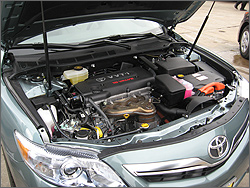Maintenance and Safety of Electric Vehicles

PHEVs and HEVs require the same general maintenance as conventional vehicles, but all-electric vehicles require less maintenance because they have fewer moving parts and fluids to change.
Maintenance needs and safety requirements for plug-in hybrid electric vehicles (PHEVs) and hybrid electric vehicles (HEVs) are similar to those of conventional vehicles, while all-electric vehicles require less maintenance. Manufacturers are designing these vehicles and publishing guides with maintenance and safety in mind.
Maintenance Comparison
Because PHEVs and HEVs have internal combustion engines, maintenance requirements are similar to those of conventional vehicles. The electrical system (battery, motor, and associated electronics) typically requires minimal scheduled maintenance, and brake systems generally last longer than those on conventional vehicles because of regenerative braking.
All-electric vehicles typically require less maintenance than conventional vehicles because:
- The battery, motor, and associated electronics require little to no regular maintenance
- There are fewer fluids, such as engine oil, that require regular maintenance
- Brake wear is significantly reduced due to regenerative braking
- There are far fewer moving parts relative to a conventional fuel engine.
Battery Maintenance
The advanced batteries used in these vehicles have a limited number of charging cycles (the number of times the battery can be charged and discharged, also called "cycle life"). Check with the dealer about battery life and warranties and consider the manufacturer's battery recycling policy. Some automotive battery systems use liquid coolant to maintain safe operating temperatures. These systems may require regular checks. Ask your dealer or refer to your owner's manual for more information.
The batteries in electric-drive vehicles are generally designed to last for the expected lifetime of the vehicle. Like the engines in conventional vehicles, the advanced batteries in electric vehicles (EVs) are designed for extended life but will wear out eventually. While comprehensive data on EV battery failures is not available, many manufacturers offer 8-year/100,000-mile warranties for their EV batteries.
Manufacturers typically do not publish pricing for replacement batteries, but if the battery does need to be replaced outside the warranty, it is expected to be a significant expense. However, battery prices are expected to decline as technology improves and production volumes increase.
Safety Requirements
Commercially available electric-drive vehicles must meet the Federal Motor Vehicle Safety Standards and undergo the same rigorous safety testing as conventional vehicles sold in the United States. The exception is low-speed electric vehicles (also called neighborhood electric vehicles), which are subject to less-stringent standards because they are typically limited to low-speed roadways as specified by state and local regulations.
All-electric vehicles, PHEVs, and HEVs have high-voltage electrical systems that typically range from 400 to 1,000 volts. Their battery packs are encased in sealed shells and meet testing standards that subject batteries to conditions such as overcharge, vibration, extreme temperatures, short circuit, humidity, fire, collision, and water immersion. Manufacturers design these vehicles with insulated high-voltage lines, and light-duty vehicles are required to have safety features that can deactivate or isolate the electrical system when they detect a collision or short circuit. All-electric vehicles tend to have a lower center of gravity than conventional vehicles, making them more stable and less likely to roll over.
Emergency Response and Training
In general, emergency response for electric-drive vehicles is not significantly different from that of conventional vehicles. Most electric-drive vehicles are designed with cutoff switches or have available methods for first responders to isolate the battery and disable the electric system, and high-voltage power cables typically are clearly designated with distinctive coloring or markings (usually orange).
Many manufacturers publish emergency response guides for their vehicles (see an example from the National Fire Protection Association), and first responders are highly encouraged to reference these guides. The National Fire Protection Association also has training and information resources available at evsafetytraining.org.
Electric vehicle fires involving the high-voltage battery can present unique challenges to firefighters, often requiring different techniques. First responders should refer to the manufacturer guides and training resources noted above when responding to an electric vehicle incident or fire and should also be aware of the potential for delayed ignition of a damaged vehicle or reignition of a battery fire, even after it is believed to be extinguished.


